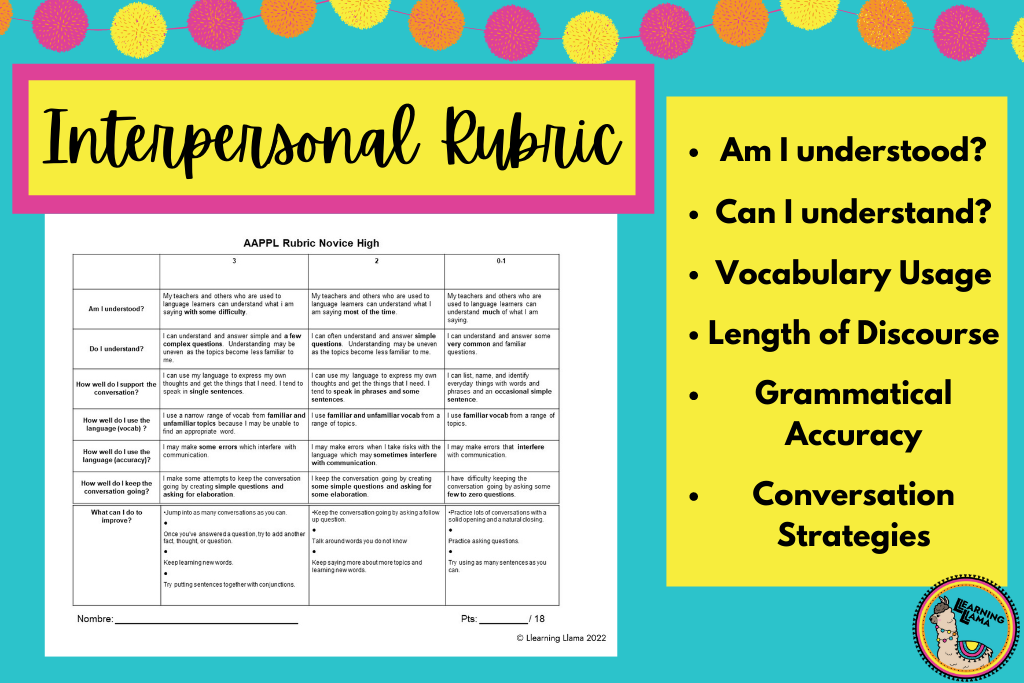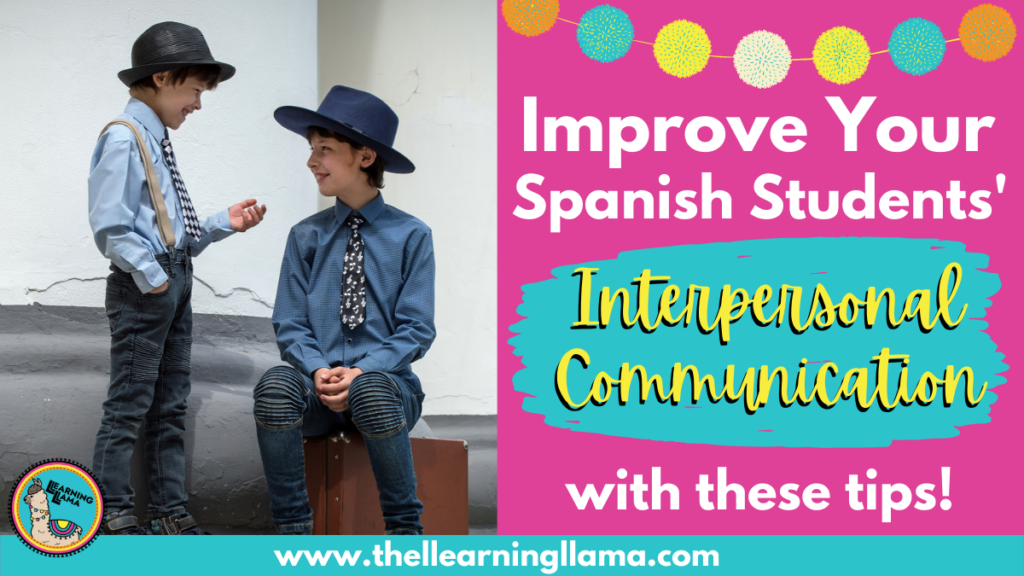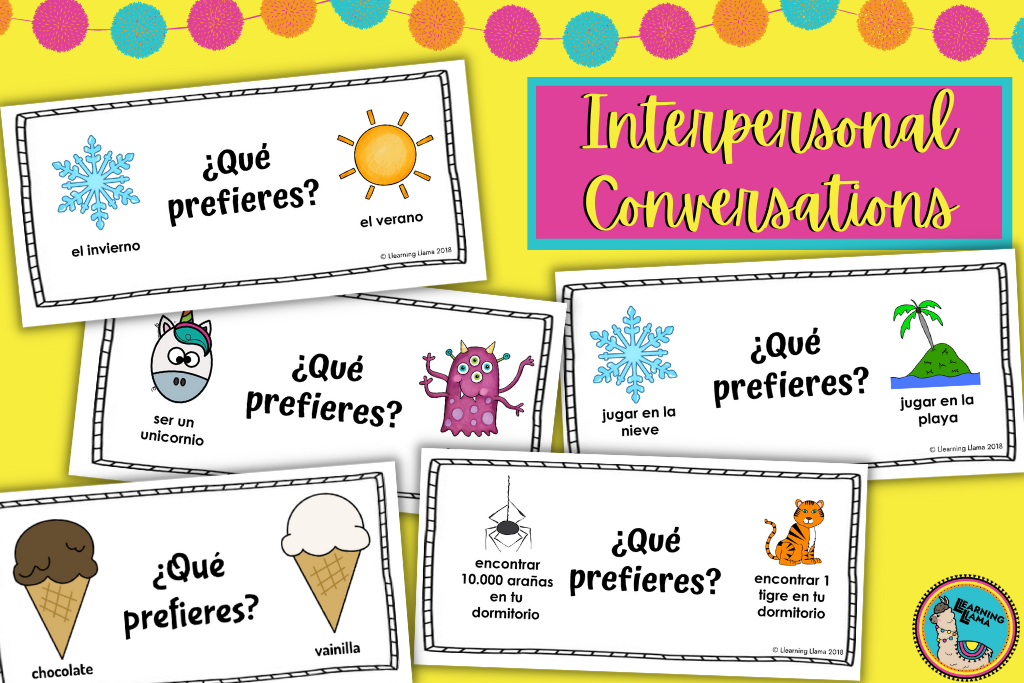Developing interpersonal communication skills is probably the skill our students dread most about Spanish class. Speaking spontaneously in the language without prep time can be nerve-wracking. So, let’s learn how we can make interpersonal communication easier and less stressful while increasing proficiency. This is blog 4 of 5 in a 5-part blog series on teaching Spanish with the Communicative Method. Make sure to check out the other blog posts on the Interpretive Mode and Presentational Mode, too!
Interpersonal Communication Definition
Interpersonal communication is two-way, spontaneous communication. This can take the form of speaking and listening in a conversation or writing quick messages back and forth. The key word in this definition is “spontaneous.” Students should not come fully prepared to an interpersonal conversation. We want them to have negotiation of meaning in an authentic conversation.
How to Create Authentic Interpersonal Tasks
Creating authentic scenarios for conversations will make our students have more meaningful communication. An authentic scenario is a situation that students could potentially encounter in the real-world or that has a greater purpose than just “for a grade.” To come up with authentic situations, imagine all the times you communicate with other people on a daily basis.
- You wake up and talk to your family about their upcoming day.
- You ask coworkers how their weekend was.
- You send emails to parents, friends, colleagues.
- You text your family members to make plans for the weekend.
- You call the dentist to schedule an appointment.
- You message the Airbnb host for your upcoming trip.
- You call the Guidance Office to discuss a student’s performance.
The list goes on and on and on. Try to think about the different themes in your curriculum. What authentic scenarios could occur in each of those themes? For a health unit, your students can visit a doctor’s office or a nutritionist to discuss health concerns and get advice.
Implementing Interpersonal Tasks in the Classroom
The key is making the task “spontaneous” and not prepared. Don’t give them too much time to prep for the conversation. In real life, we don’t get that extra time. You may want to give them the prompt or general topic of conversation ahead of time so they aren’t worried or anxious, but giving them too much time actually increases their anxiety.
My Go-To Interpersonal Tasks for Any Class
- Speed Dating – Students stand in two lines, across from another student. Pose a question, and they will discuss for 30-60 seconds. Then one line rotates to the next student. And you’re onto the next question! They can be questions about your content, vocabulary, or something fun like Would You Rather. This is a great idea for a class warm-up to get students up and moving at the start of each class period.
- Turn and Talk – My students are always sitting in groups of 3-5. I don’t go 15 minutes without having them turn and talk about whatever we are discussing. This gives them ample practice on the spot with the target language. I’m also always walking around and joining in on their conversations.
- 4 Corners/2 Sides– In each corner or side of the room, post a different generic answer (frequency words like siempre, nunca, a veces) (agreement terms like estoy de acuerdo/a favor or no estoy de acuerdo/en contra) or (Sí/No) Ask questions and students move to the appropriate spot. Then, they must discuss why they went to this answer.
The Best Tools for Interpersonal Communication Tasks
Use apps to implement technology into communication, just like we do everyday. Have them communicate on Google Hangouts. They could write emails back and forth.
For interpersonal writing, without technology, grab this free blank texting template for them to pass back and forth. I usually time them as they do this. I put a big countdown timer on the screen for 30-60 seconds. The students have to write their message in that time. They are not allowed to pass the paper to their partner until the time is up. Then, I start the timer again. We do this cycle of passing back and forth until the entire sheet is filled up with interpersonal messages!
How to Assess Interpersonal Communication
Logistics in the Classroom
Implementing these tasks is where it gets tricky logistically. We have limited time with our students, so we want to make the most of it. How can we assess classes of 20-30 students for their speaking skills and essentially lose an entire class period or even two?!
I have two suggestions to get around this: Either pull the students into the hall in small groups while the remainder of the class is working on a writing task, game, or project. Or have the students use their phones to record on Google Voice and share the final product with you.
In my classroom, I pull the students in groups of 3-4 into the hallway. This eliminates the anxiety of standing in front of the class or having your peers overhear your conversation. Then, I give the group the speaking prompt and tell them to begin. It is completely on the spot with no preparation time. I’m looking for an authentic conversation. How well can they carry on a conversation, elaborate their own ideas, and ask questions? If you want all students to complete the task at the same time, then they should sit in small groups and one of them will record the conversation on their phone and submit it to you. You won’t be there live to chime in or offer immediate feedback, but you can replay the conversation and assess it.
Rubrics for Interpersonal Communication Skills
I always use a rubric when assessing interpersonal communication. While they are speaking in small groups, I am simultaneously checking off the rubric for their grade. Who doesn’t love grading on the spot? That means you don’t have to grade after school or on your prep! The grade is complete by the time they finish their conversation! Immediately following the conversation, give feedback!! The conversation is fresh in their minds and in yours. Don’t wait to review their conversation with them. Tell them what went well and how to improve.

Use a rubric that reflects the ACTFL standards for their proficiency level. Remember to include proficiency levels above and below their current proficiency so they can see where they came from and what their future goal is. Some categories to include on your speaking assessment rubrics are:
- How well the student is understood
- How well the student understands their group members
- Vocabulary usage
- Length of discourse
- Grammatical Accuracy
- Conversation strategies and asking questions
Bonus Tips!
Interpersonal communication is not just oral communication. It can be written, too! Think of texting and emailing and social media!
Take the pressure off students by making them as comfortable as possible during these conversations. Don’t put them in front of the class. Let them sit down in a circle together. Smile as they talk, and give positive feedback immediately after their conversations.
Next week will conclude the blog series with a look at combining all 3 modes of communication!







4 Responses